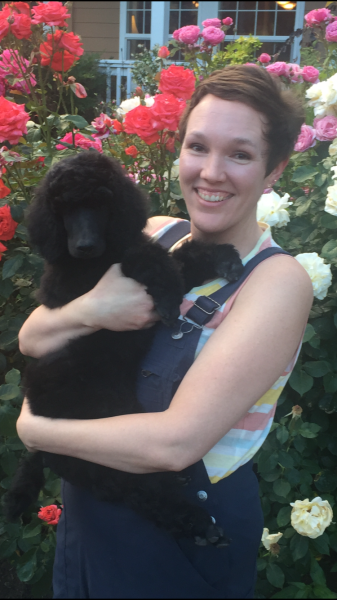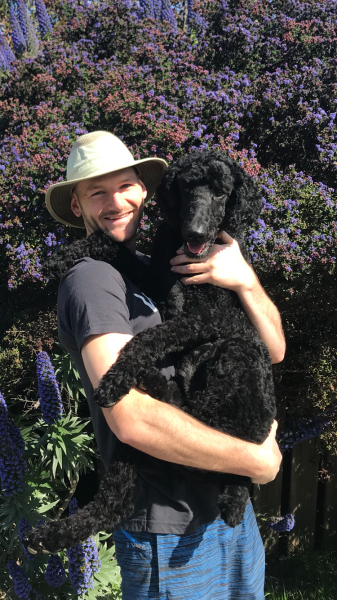Notes From a Pandemic: April 4th, 2020
by Miles Raymer
Greetings, dear friends of the present and curious citizens of the future.
“Getting sick is different now.”
In a conversation with my wife Jessie, these words tumbled out of my mouth before I could give much thought to what they meant. This is a fairly common experience for me, which means I spend a lot of time either trying to understand things I’ve said or trying to escape their consequences. In this case, I realized that this sentence captures the weird combination of novelty and mundanity that pervades the COVID-19 pandemic. Few things are less surprising than waking up coughing or running a low-grade fever at the back end of flu season. But that’s exactly what we fear most at the moment.
This is just one of many ways the pandemic twists the features of everyday life into potentially-sinister portents. On the rare occasions when I leave my house, I’m wary of every surface, hyper-attuned to the movements of those around me, and constantly maneuvering to create more personal space for myself and others. Grocery shopping––which I’ve never loved––now feels like entering a big metal box full of visible things that will keep me alive and invisible things that might kill me. I’ve always had a great relationship with doorknobs, but we broke up two weeks ago and I’m not expecting to get back together anytime soon.
Is my fear beginning to border on paranoia? Yes, I think so. But is non-debilitating paranoia an appropriate response to the present moment? I believe it probably is. I say this as someone who distrusts paranoia and works to reduce its influence in my own mind and my community. But here we are, all together, one globe-spanning species crammed into the tail end of a shit-show bell curve.
On that note, let’s go to the numbers. Between this moment and my last journal one week ago:
- The number of confirmed COVID-19 cases in the world increased by a factor of 1.80 (180%)
- Confirmed US cases increased by a factor of 2.58 (258%)
- Confirmed California cases increased by a factor of 2.54 (254%)
- Confirmed Humboldt County cases increased by a factor of 2.86 (286%)
- Total US deaths increased by a factor of 4.28 (428%)
- The US death rate is doubling every four days
- The US is now home to 25.43% of the world’s total confirmed cases, and 12.69% of the world’s total confirmed deaths
Since these journals have become much more data-driven than my usual writings, I’d like to take a moment to address what these numbers mean and what they don’t. I’ve been watching the statistics daily with a combination of horror and unsettling pleasure. People like me are rubberneckers now in the worst way, addicted to the most minute developments in a slow-motion global car crash. And the numbers––the glorious numbers––give us a false sense of security. Even if the story they tell is dire, we can at least calibrate our reactions to match the true scale of the problem.
But can we really? After this week, I don’t think so. I am increasingly doubtful that worldwide testing is revealing the actual number of infections––something doctors and scientists openly admit is difficult to do given the suspected percentage of asymptomatic cases. This excellent article in The Economist and this supporting article by the Mayor of Nembro, Italy, make a strong case that our mortality estimates are also likely failing to communicate just how thoroughly this virus has infiltrated the regions where it is most destructive. Although more than 3,500 deaths are presently attributed to COVID-19 in New York, future updates may reveal that the death toll was much higher at this point in that state’s tragic battle with the virus.
To be clear: I am not saying that the available statistics on COVID-19 are useless, nor would I argue that the majority of governments and institutions trying to grasp and communicate the scale of the pandemic are doing so in bad faith. I think we’re dealing with a massive, distributed case of Hanlon’s Razor here. Acts of intentional deception, though possible, pale in comparison to the larger truth that humanity just wasn’t ready for anything like this, and possesses neither the plans nor the tools to generate a comprehensive model of the pandemic in real time.
This is admittedly a very high bar, perhaps not one we should expect ourselves to clear given the circumstances. So while the numbers will continue to develop and hopefully become more accurate over time, we should focus on what we do know, which are the fundamentals of how to avoid further infection. It’s certainly possible that our current tactics (sheltering in place, social distancing, frequent hand-washing, avoiding touching our faces, wearing masks and gloves in public, etc.) are flawed, but for now it seems prudent to seek stability and agency primarily through these close-to-home habits.
What’s it like to be the Director of Human Resources for a small business right now?
For readers who might not know this, my “real job” is serving as the Director of Human Resources for a cannabis company here in Humboldt County. I didn’t actively pursue HR as a career path, but fell into it over the last few years after joining the company in 2016 to work on licensing projects. And although it’s got its low points like any job, I’ve come to enjoy it. Sometimes I even think I love it.
Without a doubt, the last three weeks have been the most challenging of my professional career. On March 16th, we executed a hasty shutdown of all “non-critical” functions. While anticipated loss of revenue was definitely a concern, our primary motivation was to proactively prevent COVID-19 from entering our workforce. Since the shutdown, I’ve been scrambling to understand the legal, financial, and ethical strands that any company experiencing this crisis will need to weave into a web of survival. And while my team and I have been able to squeeze a few wins out of a bad situation, our unhappy mandate is to prioritize the sustainability of the collective enterprise over the individual well-being of our employees. Worst of all, we don’t even know if making all these brutal choices will save us in the end.
I harbor a huge amount of ambivalence about this situation. I’m thrilled that my capacity for problem-solving can help me earn a paycheck, but I’m uncomfortable with the imperious nature of the company’s bottom line. Working in HR has been an invaluable crash course in practical ethics, yet I’m repulsed by how easy it has become to treat people as mere economic units. I love my team and derive motivation from wanting to help them succeed, but watching them struggle can leave me crying inexplicably at 5:33 AM while I’m putting dishes away and NPR drops that perfectly-melancholy filler music.
What’s keeping me sane?
It sounds trite, but I feel like everyone is rediscovering the importance of friendship right now. I’ve been on the phone and in video chats with more friends in the last month than I probably reached out to in the whole previous year. In late 2019, I published a series of essays about the nature of friendship, the last of which argued that friendship is the crucible in which our global identity should be forged. This feels quaint and naive compared to the truly harrowing crucible of COVID-19, but this experience is teaching me new things about my own ideas. When I wrote that “The simple act of being with our friends is our purest expression of how we want the social world to be,” I had no idea how that sentiment would land in a moment when friends everywhere are suddenly cut off from each other yet strangely closer than ever.
Despite the escalating harms of misinformation, there’s so much amazing journalism and media coverage going on right now. Ed Yong’s remarkable piece in The Atlantic restored my faith that we can still muster the intelligence and courage not just to manage this pandemic better than we’ve been able to thus far, but also to learn the proper lessons as we go. This American Life’s episode “The Test” helped me connect with strangers across the country whose lives have been upended far more drastically than my own. And I couldn’t have been more excited to listen to Dan Carlin’s first Common Sense podcast in years.
Jessie and I celebrated the first birthday of our dog, Albus, on Wednesday. It’s such a joy to shelter in place with someone who doesn’t have any idea that the reason his parents are now home all the time is because they might die or accidentally kill someone else if they go out.
In an effort to lighten the mood without becoming completely saccharine, we started rewatching Northern Exposure, one of my all-time favorite shows. Even though the Russian Flu episode hit a little too close to home, it’s been lovely to revisit this tale of a New York doctor forced to work off his medical school debt in a quirky Alaskan town. Combined with a cold bottle of Mad River Brewery‘s Jamaica Red, the citizens of Cicely bring solace to the pandemic-stricken mind.
Starting on Thursday, we began participating in the “Nightly Howl” at 8:00 PM. This is just one version of a new tradition popping up all over the planet. The idea is for people to go outside all at the same time and howl together, sending good will to our neighbors, signaling support for our medical professionals and essential workers, and expelling the tensions of the day. I’ve always found howling to be equal parts primal, plaintive, and empowering––just right for expressing solidarity at a distance.
Until next time, be well, and good luck.


Sending love to you, Miles. As always, I appreciate your wisdom and clarity of thought.
Missing you, and hoping you and your stay face.
Thanks as always for reading, Katie! I am wishing the same for you and yours. 🙂
I felt the mix of emotions in this piece!
Sending you and your family lots of love!
Back atcha Edie and thanks for reading! 🙂
While this is a beautiful piece, I want to clarify that while humanity might not have been “ready for anything like this,” the government should have been. The military knew this was coming and nobody heeded the warnings: https://www.thenation.com/article/politics/covid-military-shortage-pandemic/
Politics aside, you have a facility for articulating what many of us are feeling right now. Thank you for this.
Thanks Dad and good point!
For me, your comment brings up the thorny problem of having actionable information available vs. translating that information into appropriate action. It strikes me that while we are fairly good (at least in historical terms) at gathering and analyzing information that would help us prepare for or even prevent something like the COVID-19 pandemic, our national/global ability to execute precise, scalable, and effective action based on that information is comparatively poor.
This problem pervades human civilization at pretty much every level, including within each of our individual minds. I don’t think we’ll resolve it anytime soon! 🙂
All of that said, it is of course disgraceful and unforgivable that the Trump administration failed to properly heed the 2017 Pentagon Plan you referenced.